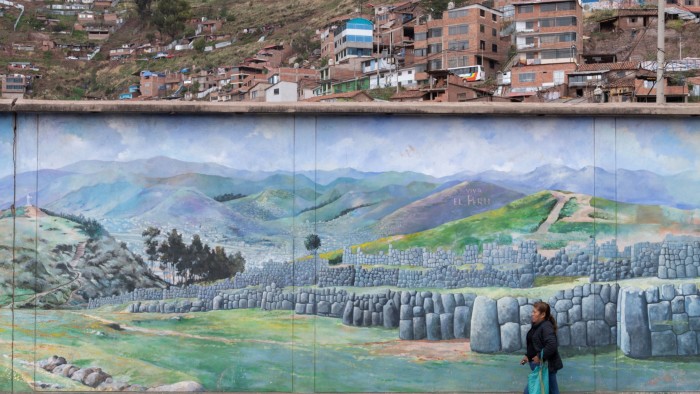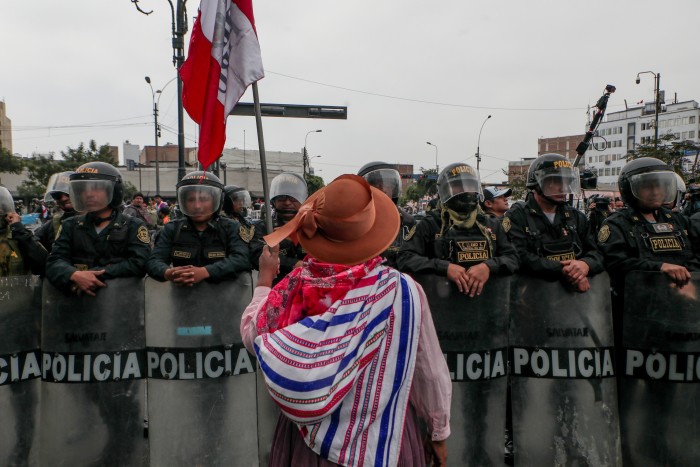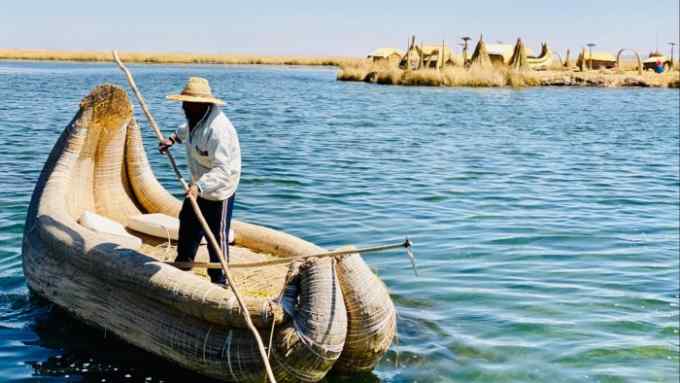Peru pulls back from the brink but path to growth is rocky

Roula Khalaf, Editor of the FT, selects her favourite stories in this weekly newsletter.
Like a climber who has taken a tumble, narrowly dodging a ravine, Peru is picking herself up and contemplating two possible futures: a continued ascent towards the peaks, or the risk of another downward slide.
President Dina Boluarte’s government hopes foreign investors will help the Andean nation return quickly to the path of steady growth that allowed millions of Peruvians to ascend the economic ladder over the past two decades.
As a mining powerhouse, a large exporter of fruit and vegetables, and a magnet for tourism, Peru has been Latin America’s fastest-growing major economy this century. And its strategic position on the Pacific, its extensive free trade agreements, and its plentiful reserves of copper, gold and silver should position it for further prosperity.
Yet a period of political turmoil, with five changes of president in under five years, has stunted the economy and created uncertainty about the future.
Peru’s biggest tumble in recent times occurred last December, when the country’s radical leftwing president Pedro Castillo announced on television that he was closing Congress, seizing extraordinary powers and ruling by decree — an echo of actions taken in 1992 by one of his predecessors, Alberto Fujimori.
Unlike Fujimori’s successful “self-coup”, Castillo’s power grab lasted but a few hours: Congress, the judiciary, the armed forces and key figures in his own cabinet all disowned him, and the former rural primary school teacher fled the presidential palace. Police arrested him en route to the Mexican embassy to seek asylum, and he has been in jail since.
Following Castillo’s impeachment by Congress, power passed to Boluarte, a former provincial lawyer who had not held elected office until she stood as vice-president on the ticket of Castillo’s Marxist-inspired Perú Libre (Free Peru).
The drama did not end with her inauguration. Protests swept the country as Castillo’s supporters demanded her resignation and his reinstatement. In the impoverished south, some demonstrations turned violent and the new government ordered in troops and police, with tragic results: 49 protesters were killed.
Six months on, the protests have died down, prosecutors are investigating the killings and a fragile calm has descended. The government is now turning its attention from quelling disorder to propelling the economy forward.
Alberto Otárola, prime minister, sees private investment as the key to Peru’s revival. “We are trying to do all we can to boost it,” he says in an interview with the Financial Times in Lima’s ornate Palace of Government. “We are having business roundtables and meetings all the time, and we are travelling to promote our country overseas.”
One test of the government’s ability to turn good intentions into real changes will be mining — a mainstay of the economy. Some $53bn of big projects have been stalled for years by what the industry views as bureaucratic inertia, complex regulation, and simmering protests.
“We are absolutely aware that the topic of simplification is a major problem and what we have been doing recently has been about unblocking [projects],” says Juan Carlos Mathews, foreign trade and tourism minister. “This is an important signal.”
Mining companies want simplification of the permit process, handled by more than a dozen state entities. They also say the government must deliver infrastructure improvements to ensure sceptical rural communities feel an economic benefit from mining projects.
“The state needs a bigger and more continuous presence on the ground in rural areas,” says one mining executive. “At the moment, it comes and goes and the population don’t trust it. We have lost the predictability around investment, which was so important.”
Castillo’s election on a radical manifesto pledging widespread nationalisation, big tax rises and a rewrite of the investor-friendly constitution sent shockwaves through Peru’s business community. Wealthy Peruvians rushed to buy apartments abroad and move assets offshore. Almost $20bn left the country, according to finance minister Alex Contreras — the biggest capital flight in more than half a century. A little has returned this year but most remains abroad, awaiting a more stable climate.
Boluarte’s government calmed nerves by following a more pragmatic course and building alliances in the fragmented Congress with rightwing parties.
But while this has eased business fears, it has done little to please the people in a highly divided country suffering some of the worst inequality in Latin America.
Poverty levels fell by two-thirds between 2004 and 2019, according to the World Bank, but rose in the wake of Covid-19, which hit Peru especially hard; the country had the highest per capita mortality in the world, according to Johns Hopkins University data.
The World Bank estimated this year that four in 10 Peruvians were at risk of falling into poverty — the most since 2004 — and about three in every four workers are in the informal sector.
December’s political upheaval and its aftermath have scarred the economy. At the end of August, the government slashed its growth forecast for 2023 to 1.1 per cent, citing the violent protests, plus the effects expected this year from El Niño — a warming of the Pacific Ocean that changes weather patterns.
Still, Contreras is confident that growth will bounce back to 2-3 per cent next year, helped by an economic recovery programme, “Con Punche Perú”, whose logo is an arm flexing its muscles.
“There are 13 laws already approved to boost investment and . . . already more investments announced than last year,” says Contreras. “Public-private partnerships are at a record level, around $1.8bn this year against $98mn last year. There is a clear improvement.”
The business community approves: about 70 per cent of chief executives interviewed by pollster Ipsos in July were happy with Boluarte. “Compared to the previous government, it’s as if we’ve moved to Switzerland,” says Alfonso Bustamante, president of the business lobby group Confiep.
But the president’s national approval rating has slid steadily since December and languished at 10 per cent in September, noted pollster IEP. Only Congress, hit by multiple corruption scandals, fared worse, with 6 per cent approval.
“We have a thirst for leadership,” says Oswaldo Molina, director of the Red de Estudios para el Desarrollo, a think-tank. “Politics has failed us Peruvians.”

Peru’s greatest living novelist, Mario Vargas Llosa, noted in his memoirs, El Pez en el Agua (A Fish in the Water), “that lack of conviction, that premature and essential pessimism which is the disease par excellence of the best people in Peru”. And pessimism is easy to find in Lima. “Congress won’t allow serious reforms and the government lacks the authority to push anything through,” laments Alberto Vergara, a political analyst. “You have reciprocal mediocrity.”
Still, there are optimists. “We stared over the precipice and, in a marvellous surprise, we pulled back from the precipice,” says former finance minister and business consultant Alfredo Thorne. “We Peruvians are very inclined to be pessimistic but something good always happens, which makes us keep going.”

Comments